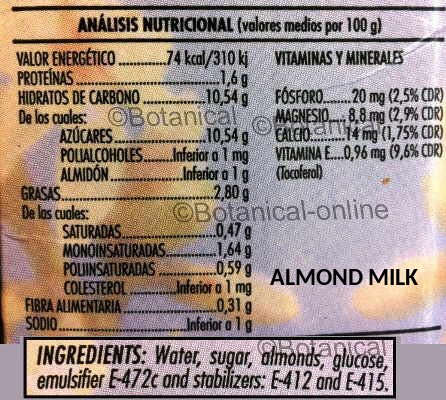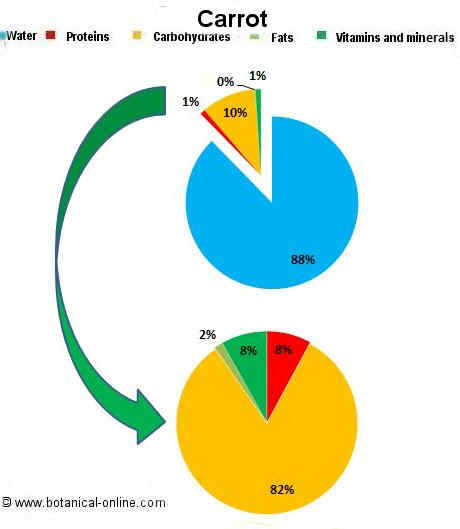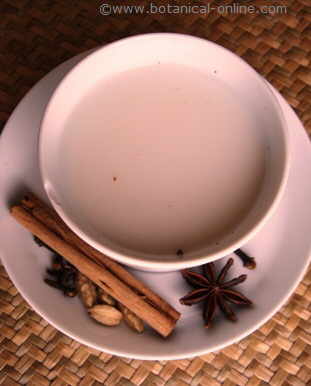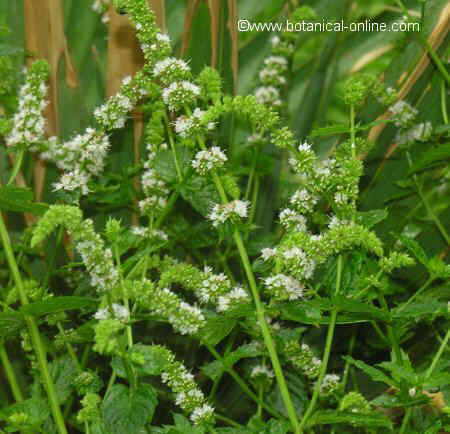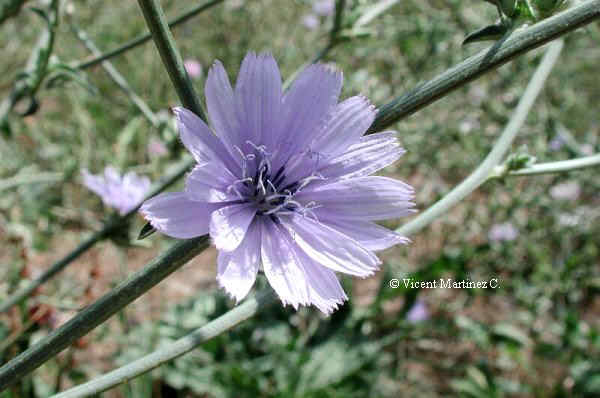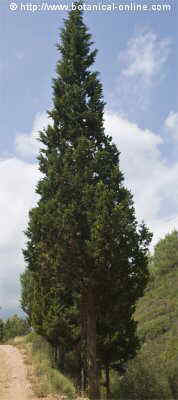Contents
What is a loquat tree?
Loquat characteristics
Common English name: Japanese loquat, Japanese medlar, medlar-tree, Japanese plum, loquat, stinking toe, green loquat, Brazilian loquat.
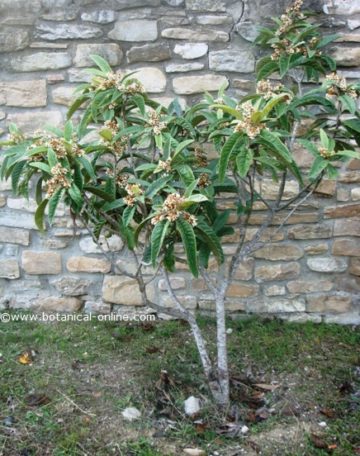
Scientific name: Eriobotrya japonica (Thunb.) Lindl.
Etymology: Eriobotrya genus comes from the Greek words Erion, which means “wool” and botrys, which means “cluster”; referring to the hairy inflorescences of this plant. Japonica refers to Japan, one of the countries from which this species comes.
Other taxonomic designations:
– Mespilus japonica Thunb.
– Photinia japonica Benth. And Hook.f. Ascher ex. And Schweinf.
Japanese loquat in other names
Family: Rosaceae
Origin: native fruit tree of Southeast China (Chongqing, Hubei), where it is known for more than 2,000 years ago. This species was introduced in Japan, where it is cultivated since 1180.
Where to find loquat trees?
Habitat: Medlar is one of the few sub-species of the family Rosaceae. It is cultivated as a fruit and ornamental tree throughout the European and Asian continent, New Zealand, Brazil, Argentina, among others.
Distribution: Medlar was introduced in Europe in 1690, it is believed that the Jesuits, who brought it from Japan to the island of Mauritius, and from there to France.
From France it spread throughout the Mediterranean region, and it is now a naturalized tree in Algeria, Turkey, Israel, Italy, Spain, New Zealand, Brazil, Argentina and southern US
Description of loquat or medlar
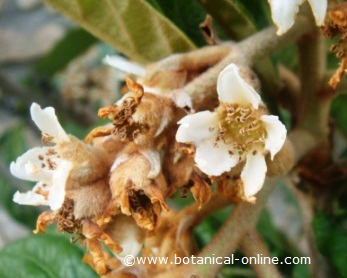 In the image, a detail of a flower of Japanese medlar
In the image, a detail of a flower of Japanese medlar
Japanese medlar (loquat) is an evergreen fruit tree of the rose family, the same family that owns many fruit trees in the world, such as apple, quince, cherry, apricot or hawthorn.
Note that there are two species of medlars. The most popular is the medlar of Japan (Eriobotrya japonica), which is the present species. There is also the European or common medlar (Mespilus germanica)
Eriobotrya japonica trunk is erect and thick, with grayish wood. It is generally a low tree, from to 6, to 10m., And requires care and pruning to develop strong structure. Rounded and broadly conical crown.
The trunk branches in 2-5 arms. The primary branches branch into secondary branches. Young twigs are brown and hairy.
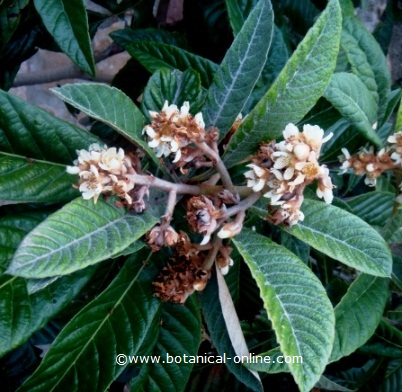 In the picture: leaves and inflorescence of Japanese medlar. Large leaves and flowers are arranged in panicles
In the picture: leaves and inflorescence of Japanese medlar. Large leaves and flowers are arranged in panicles
Loquat leaves are simple, alternate, with woolly petiole (6-10cm. In length), leathery, elliptical, lance-shaped and large, from 15 to 40cm. 7-13cm in length. wide. Toothed margins. Apex acuminate or acute. Sometimes sessile (without petiole). Well marked veins are distinguished. Make glabrous and shiny, dark green. Brownish tomentose below.
The inflorescence is a panicle, 2,5-20cm. long, with a shaggy appearance, where the flowers of the plant appear. Pedicels of 5-8mm. of length.
Loquat flowers are white, 1.2 cm. wide. They give off a pleasant scent. Hermaphroditic flowers are pollinated by insects, being a honey plant.
This tree attract many garden wildlife: bees, butterflies, flies, wasps and ants.
Flower parts: The calyx of the flower consists of 5 small acute lobes, corolla of 5 petals oblong, white and delicate texture. It has 20 tamens and five pistils.
Japanese medlar flowers in autumn.
The fruit is a drupe, also known as loquat, measuring between 3 and 6cm. long by 1.5 – 5cm. wide and ellipsoidal. Fruit skin is hard, thick and soft. The flesh is hard and juicy, having a sour and sweet flavor.
Inside the fruit there are between 1 and 3 seeds (sometimes up to 5), shiny brown, 1-2cm. long.
Loquat fruit is consumed by humans, birds and common bats, fruit bats (Rousettus aegyptiacu), frugivorous bats (Artibeus lituratus), animals that disperse their seeds naturally.
The roots of this fruit tree are branched and remarkably deep. It has a taproot that can attain 2.5m. maximum depth. The secondary roots do not reach 30cm.
Used parts of loquat tree
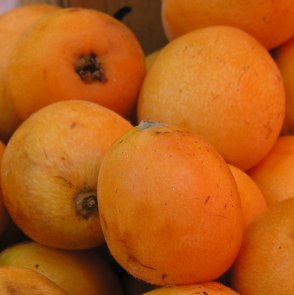 Loquat fruits
Loquat fruits
- Fruit: It produces a yellow fruit, also called loquat, being present in almost every market. It can be eaten raw or cooked (in jellies, jams, syrups, sauces, pies, puddings, sweets, cakes). It has an acid sweet taste, which can remind that of a cherry. With loquat spirits are also produced. The fruit can be dried or frozen. ( More information on fruit properties)
- Leaves: sometimes used for medicinal purposes.
- Wood is used for handicrafts or for firewood.
- Seeds: seeds consumption is not recommended, because they can be toxic. (* More information on loquat toxicity). In some countries, these seeds are roasted and used as a coffee substitute.
Japanese medlar uses
- Ornamental tree: Medlar is a typically ornamental tree, because of its low rise, used for terraces and gardens. Easy to grow, it grows well in large pots or containers. Because it attracts insects it is not recommended to plant near pools, picnics, etc.
- Honey: This autumn flowering tree is suitable for honey.
- Medicinal: Its fruits are sedative, antiemetic and highly astringent. The flowers are used for its expectorant properties. Taken in infusion, the leaves are a traditional remedy for depression and cold. The poultice of leaves are used to reduce inflammation swelling.
- Cultivated fruit: according to data from the FAO in 1999, China is the leading producer of loquats, followed by Spain, Japan, Italy and Brazil.
- Wood: It pink wood is strong, being used to make musical instruments, crafts, garden fences and firewood.
Composition of loquat
- Carbohydrates, mainly in the fruit, are sugar and fructose. Pentosans in the seed.
- Fats: mainly in seeds. In the fruit in very small quantities.
- Protein: mainly in seeds. In the fruit in very small quantities.
- Fiber
- Vitamins: thiamine, niacin, riboflavin, mainly.
- Carotene: mainly cryptoxanthin and betacarotene. They have also been analyzed: violaxanthin, zetacarotene, auroxhantin, neurosporene.
*Related information: Benefits of loquats
Scientific studies conclude that the loquat is an excellent source of provitamin A.
Composition of loquat per 100g | |
| Nutrient | Amount |
| Water (g.) | 86,73 |
| Calories (kcal.) | 40 |
| Carbohydrates (g.) | 12,14 |
| Proteins (g.) | 0,43 |
| Fats (g.) | 0,20 |
| Fiber (g.) | 1,70 |
| Vitamin C (mg.) | 14 |
| Vitamin B1 or thiamin (mg.) | 0,02 |
| Vitamin B2 or riboflavin (mg.) | 0,03 |
| Vitamin B3 or niacine (mg.) | 0,18 |
| Vitamin B6 or pyridoxine (mg.) | 0,10 |
| Folates (mcg.) | 14 |
| Calcium (mg.) | 16 |
| Magnesium (mg.) | 13 |
| Phosphorus (mg.) | 27 |
| Sodium (mg.) | 1 |
| Potassium (mg.) | 266 |
| Iron (mg.) | 0,28 |
| Zinc (mg.) | 0,05 |
| Copper (mg.) | 0,04 |
| Selenium (mcg.) | 0,60 |
- Minerals: potassium, phosphorus, sodium, magnesium, calcium, iron, zinc, copper
- Tannins: give it the fruit astringent properties.
- Flavonoids: kaempferol, quercetin
- Organic acids: caffeic acid, malic, succinic, ursolic (antioxidant), tartaric.
- Triterpenoid saponins in flowers, with expectorant properties. In some regions, a loquat flower tea is prepared as cough medicine.
- The seeds contain amygdalin (antiinflammatory, antitussive, anticancer, toxic).
| Botanical classification | |
| Kingdom | Plantae |
| Subkingdom | Tracheobionta Vascular plants |
| Superdivision | Spermatophyta Seed plants |
| Division | Magnoliophyta Flower plants |
| Class | Magnoliopsida Dicotyledonous |
| Order | Rosales |
| Family | Rosaceae |
| Subfamily | Spiraeoideae |
| Tribe | Pyreae |
| Gender | Eriobotrya |
| Species | E. japonica |
![]() More information on loquat.
More information on loquat.


